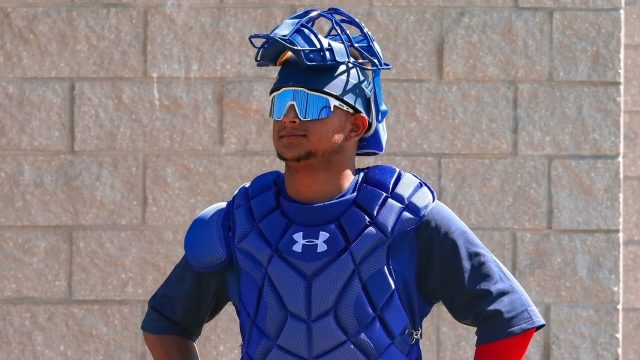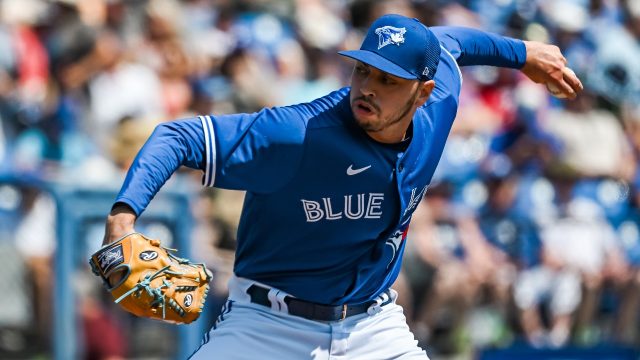
BUFFALO, N.Y. – About a month after he signed with the Toronto Blue Jays in August 2016, the perils of catching began to wear on Gabriel Moreno. His forearms and biceps were covered in bruises as he struggled to learn to block balls behind the plate. The rest of his body took a pounding, too, and it was a grind mentally. He missed playing shortstop. He feared he’d made a mistake in agreeing to learn the sport’s most demanding spot as part of his contract.
“A new position is really hard,” Moreno says. “At that time blocking was the problem for me. I was scared of the ball. That was tough. Basically, I asked my agent if he can (undo) the deal because I didn’t want to catch. The next month, I started feeling like this is my work, if I want to go to the big-leagues I need to get better at this position. That’s what I did.”
Six years later, the 22-year-old is with the triple-A Buffalo Bisons, pushing to take the next step in what’s been an impressive journey. Since those initial growing pains, Moreno has worked relentlessly to not only become competent behind the dish, but a difference-maker there.
His elite bat-to-ball skills – he’s got a Bo-Bichette-esque ability to do damage on a wide array of pitches both in and out of the zone – are a prime reason why he’s considered one of the best prospects in baseball. But his defensive growth gives him a chance to be one of the rarest commodities in the sport – a true two-way catcher.
“His flexibility is outstanding. He receives pitches well. He makes accurate throws. He’s quick behind the plate. He’s quick with his release,” says Blue Jays bullpen catcher Luis Hurtado, who worked with Moreno at multiple minor-league levels. “He’s something special that you don’t see often in a guy behind the plate.”
That Moreno is even in this position now speaks to his determination, grit and raw talent.
A native of Baquisimeto, Venezuela – a city of nearly 900,000, about 360 kilometres west of the capital, Caracas – he started playing baseball when he was five, got into organized games at the age of eight and by the time he was 10 was competing against older kids to find a sufficient challenge. At 14 he joined an academy run by Carlos Torres now known as the Champions Baseball Academy, and that’s where the Blue Jays caught his trail.
In the leadup to the 2016 international signing period, he worked out for them as a shortstop and during the session the Blue Jays asked if he’d ever caught before.
“Never,” he replied.
But Moreno offered to make some throws from home to second and the next day, while he was in the middle of a batting practice round, Torres called him with some unexpected news.
“He said to me, ‘The Blue Jays want to sign you but as a catcher,’” recalls Moreno. “I said, ‘Oh, dang.’ It was tough. But it is every kid’s dream to sign with a professional team. I did the deal and now we’re here.”

Those painful bruises followed after he signed for $25,000 and reported to the club’s academy in the Dominican Republic, jumping into what’s known as the Tricky League, an informal loop made up of newly signed international players. The next year he graduated to the Dominican Summer League, posting a .570 OPS in 32 games, but far more important was that for the first time he felt comfortable behind the plate.
It was there he first started working with Hurtado, a fellow Venezuelan who in 2018 managed him on the rookie-ball GCL Blue Jays. Moreno played 23 games there before moving up a level to rookie-ball Bluefield and by 2019, the pieces really started coming together for him.
While he initially didn’t make a full-season team out of spring training, he quickly found his way to low-A Lansing, where “he started building his name,” according to Hurtado. Despite being 2.3 years below the league’s average age, he posted an .823 OPS in 82 games while flashing the unique athleticism that’s become his calling card.
Afterwards, he and Hurtado were reunited at the club’s fall instructional league, working closely with another up-and-coming catching prospect – Alejandro Kirk. When one was in games catching, the other was given a piece of paper and asked to write down how he’d call every pitch. Afterwards, they’d all compare notes.
“(Hurtado) helped us a lot,” says Moreno. “Me and Kirk, we had a really good connection, we are really good friends. We’d talk like what pitch you called in that situation. That helped me a lot.”
Increasingly excited about his trajectory, the Blue Jays were eager to push him in camp the next spring before COVID-19 shut everything down. When borders closed, Moreno was among a group of Venezuelan players stranded in Dunedin, Fla., where they were forced to shelter in a hotel arranged by the team.
Quarantine life was especially isolating for Moreno and his teammates, who were initially limited to their rooms and the occasional outdoor workouts. The Blue Jays supplied equipment for them all to remain active and Moreno’s kit included a tennis ball, which he’d throw against the back wall of the hotel and then squat to receive.
Eventually the minor-league season was cancelled, but when Major League Baseball settled on its return to play, the Blue Jays intended to bring Moreno to summer camp in Toronto. A bout of COVID-19 scuttled that – “I lost a month,” he says – and once cleared he made it to the club’s alternate training site in Rochester, N.Y., where he continued to impress.
Moreno opened 2021 at double-A New Hampshire and was pounding the league – batting .373/.441/.651 through 32 games – when he and lefty Brody Rodning got crossed up on a ninth-inning pitch and the ball caught him awkwardly on the right thumb. Adrenaline allowed him to finish out the game, but after in the clubhouse “the thumb looked bad” due to a fracture that required surgery to repair.
The injury cost him nearly three months, Moreno returning in time to play in three games with Buffalo. To try and make up for lost time, he went to the Arizona Fall League, where he had a .904 OPS in 22 games for Mesa, and then suited up 18 times for Lara, his winter ball team back home in Venezuela, posting a .758 OPS despite being 7.3 years younger than the league average.
This spring, visa complications after the lockout was settled prevented Moreno from reps at big-league camp. But he’s hit the ground running with the Bisons, pushing his stat line through seven games to .360/.407/.520 with an RBI double and a walk in Thursday’s 7-3 win over Scranton/Wilkes-Barre, and it’s easy to find people who think his bat is big-league ready now.
Still, the Blue Jays are being deliberate with Moreno in this crucial finishing stage, both at the plate as well as behind it.
A focal point for him in recent seasons has been his swing decisions, because his ability to make contact with a wide array of pitches can be both blessing and curse. The key, Blue Jays farm director Joe Sclafani says, is “figuring out how to plan for certain pitchers, how are they going to attack him, because he’s not a secret anymore. Everybody knows him and circles his name on a lineup.”
To that end, the Blue Jays have stressed to Moreno that continually putting bad balls in play “is not going to play at the upper levels, especially when guys start to figure out his tendencies and get him to chase in spots.” He’s been receptive to that message and the notion of balancing his aggressiveness, which they want him to maintain, with being selective.
“It’s like continuing education, showing him his hot zones, the balls he does the most damage on, because (getting to pitches all over the zone) is a great ability,” says Sclafani. “You see Bo do it in the big-leagues. We had a lot of similar conversations with him. It’s educating him on the zones that he can really do damage with because he’s got a ton of juice. He can really change the face of a game when he’s up there. And it’s fun to work with a guy that talented and he’s really starting to pick it up and buy into it.”
Then there’s the defensive work, where Moreno is really on to the finer points of catching.
In simple terms, that’s being able to get the most out of pitchers while they’re on the mound, but the path there is in many ways the most difficult task at hand. Moreno, who has worked very hard on his English over the past few years so he can better connect with everyone on the staff, says his priority is to “have really good conversations with all the pitchers, more talking in between innings. If I know all the pitchers, I’ll call the game well.”
Still, the Blue Jays task their catchers with far more than that. At the big-league level, backstops are uploaded with reams of information on how to attack different hitters, situational approaches and how to exploit a host of different vulnerabilities. There are daily meetings to attend with the starters and the coaching staff. There’s video to watch. And then there’s individual work at the plate and on the field.
“They just have to deal with a lot more,” Sclafani says of catchers. “You want every pitcher to be saying, ‘I want to throw that guy on a daily basis.’”
Bisons manager Casey Candaele, who is also the organization’s minor-league field co-ordinator, believes that piece is especially complicated.
“How you handle a pitching staff and how you guide them through nine innings and call games are usually the last things to develop for a catcher, especially a young catcher that’s learning all the data, all the information they have at the major-league level,” he says. “It can be intimidating for a young catcher to go up to guys who have pitched in the major leagues and feel comfortable saying, ‘Hey is everything good? Why did you want to throw that slider in that sequence right there? What were you thinking? This is why I was thinking fastball.’ Those are some advanced advanced thoughts. The only way you learn that is to do it and feel comfortable with it. That’s what we talked to Gabby about. Like, hey, man, build it and talk to the pitchers.
“He picks it up pretty fast and he wants to learn.”
Moreno, of course, will end up deciding just how steep the learning curve is. He has an affable and engaging manner. Teammates gravitate towards him. As he’s speaking with an interviewer, several interrupt the conversation to say things like, “best hitter in the league,” and “future star, right here.” There’s a fierce competitiveness underpinning his leadership qualities, too, which is exactly why the Blue Jays are wary of rushing the process.
Still, between what he accomplished last year, his strong start this season and Danny Jansen’s oblique injury, the more Moreno hits, the more he’s going to push the debates about a promotion to the majors to the forefront, even as he tries to keep an even keel about it all.
“Just keep playing my game,” he says of the building attention around him, “keep playing like last year when I was good. Just stay focused and play my game.”
It’s what he’s done since those early days when the toll of catching tested his will. He decided then to do what it takes to get to the big-leagues. He’s almost there.






